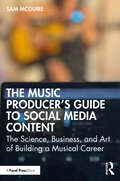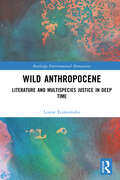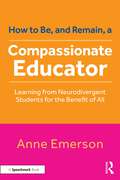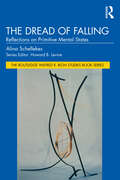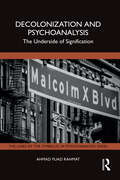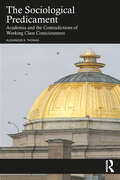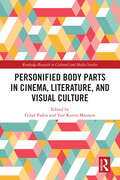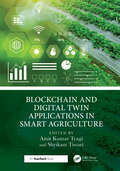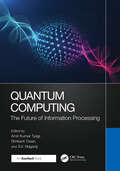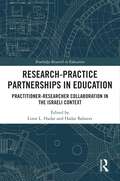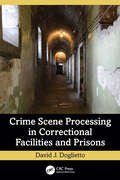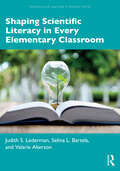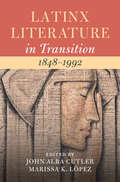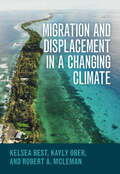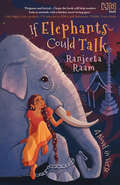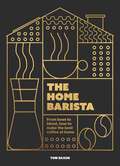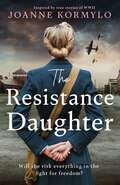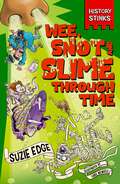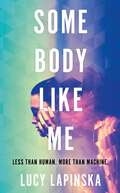- Table View
- List View
The Music Producer's Guide to Social Media Content: The Science, Business, and Art of Building a Musical Career
by Sam McGuireThe Music Producer's Guide to Social Media Content offers essential insights into the role of audio in content creation for social media platforms. It provides advice on succeeding in the music industry through the successful adoption of social media practices, and on creating high-quality content as a vehicle of career growth.Introducing both industry-standard tools, including DAWs, plug-ins and hardware, and an array of advanced techniques—such as consideration of immersive and spatial audio as well as live-streaming systems—the book equips readers to create audio for uploaded and streamed media. With a focus on maximizing quality, the book explores destinations and distribution with contemporary case studies, while focusing on principles that can be transferred to new technologies as they are released. Throughout, readers gain an understanding of the technology behind media creation, methods of using social media platforms to expand career opportunities, and the process of monetizing content.This is an invaluable companion for both novice and experienced music producers who are seeking to promote their work on social media, as well as those looking to master the art of creating audio content for social media.
Wild Anthropocene: Literature and Multispecies Justice in Deep Time (Routledge Environmental Humanities)
by Louise EconomidesWild Anthropocene examines four key areas—the politics of deep time, neoliberalism's socio-ecological impacts, global population growth and inter-species entanglement—to demonstrate how literature illuminates progressive solutions to Anthropocene challenges. The book argues that technological mitigation of contemporary environmental crises must be complimented by a politics committed to multispecies justice. Central to this new politics is the project of reimagining our relationship with time as something other than its status within capitalist praxis.The book brings together poetry and fiction written by a diverse range of writers to demonstrate how contemporary literature addresses important connections between social oppression and environmental issues. It also critiques techno-managerial visions of the future that celebrate humanity's ever-growing "control" over ecosystems by examining multiple sources of wildness (temporal, environmental and technological) that expose the problematic ideology underwriting such aspirations. Readers will be introduced to a way of understanding the Anthropocene that, while being informed by recent discoveries in earth science and evolutionary biology, also makes a strong case for humanities-based understanding of environmental politics.This interdisciplinary text will be a useful addition to theoretical discussions on the Anthropocene for scholars, researchers and students in the environmental humanities, literary studies, ecocriticism and environmental philosophy.
How to Be, and Remain, a Compassionate Educator: Learning from Neurodivergent Students for the Benefit of All
by Anne EmersonAs educators, the attitude with which we approach our work has considerable impact on the outcome for students. Our assumptions and expectations influence learning both positively and negatively.This book adopts a compassionate acceptance that all children, no matter what they say, don’t say, or do, are doing the best they can in that moment. It is in the adults’ power, and their responsibility, to understand children and barriers they experience in their learning. By exploring neuroscience, psychology, and learning theory, we can increase our awareness of brain organisation and function to help us understand why a child isn’t doing what we have asked. With understanding comes both our compassion and ability to support. The case studies and examples from the author’s practice illustrate how we can learn from effective strategies for neurodivergent children to build insight into all pupils.When we adopt a non‑judgemental and encouraging approach, we form positive collaborative relationships with children and their families that increase engagement with and enjoyment of learning and reduces our own frustration and stress. This book is valuable reading for all educators, equipping them with an understanding that allows them to work flexibly and creatively to meet the learning and emotional needs of all pupils.
The Dread of Falling: Reflections on Primitive Mental States (The Routledge Wilfred R. Bion Studies Book Series)
by Alina SchellekesThe Dread of Falling: Reflections on Primitive Mental States offers a comprehensive and original view of primitive mental states from a psychoanalytic perspective, allowing the reader to understand the nature of these states from developmental, theoretical and clinical vantage points.The book begins with a review of early mental development and its relevance to the understanding of primitive mental states. Alina Schellekes explores major primary anxieties of being and considers object relations that characterize loose or shattered structures of the self. "The dread of falling" both describes a concrete anxiety prevalent in such states and serves as a metaphor and common thread through the book to portray the deep dread of losing base with one’s meaningful objects. Schellekes looks at how, in cases of severe developmental deprivation or late-onset trauma, mental void structures or states of emotional indigestible excess may evolve, creating complex challenges in the analytic process. Schellekes explores various mental survival tactics that are often developed and deployed by patients finding themselves in such extreme cases: omnipotent self-holding defences, autistic manoeuvers, rebirth fantasies and excessive daydreaming. She discusses the quality of analytic presence that is necessary when facing unrepresented mental layers and uncentered states of mind, so as to minimize the risk of toxic states in analysis and of premature terminations.Including perceptive analyses of literary and fine art works, the book invites the reader on an intellectual and emotional journey through complex mental landscapes of patient and analyst, encompassing profound theoretical understandings and subtle clinical observations.
Decolonization and Psychoanalysis: The Underside of Signification (The Lines of the Symbolic in Psychoanalysis Series)
by Ahmad Fuad RahmatDecolonization and Psychoanalysis challenges conventional psychoanalytic assumptions by revisiting Lacan’s conceptualization of the materiality of speech through a decolonial lens.Ahmad Fuad Rahmat explores how Lacan’s ideas about the symbolic order and its historical development are intertwined with decolonial assumptions, and proposes that critically considering these assumptions can pave the way for a decolonial psychoanalysis. The book begins with how Lacan uses Freud’s Jewishness as a marginalized perspective that reveals the excluded dimensions of signification within the symbolic order, and examines James Joyce’s anti-colonial politics and its significance for Lacan’s conception of the sinthome. The book includes a critique of Slavoj Žižek’s Eurocentric reading of Malcolm X as a foil with which colonized speech could be conceived as “symbolic dispossession”. Finally, it reframes the notion of “the gap” by understanding global capitalism as a mode of exchange to advocate for a decolonial psychoanalysis that focuses on the non-spaces of transmission as opposed to a like-for-like export of the clinic from the center to the periphery.Decolonization and Psychoanalysis will be of great interest to psychoanalysts and to scholars of psychoanalytic studies, critical theory, and cultural studies.
The Sociological Predicament: Academia and the Contradictions of Working Class Consciousness
by Alexander ThomasA sociological phenomenon afflicts sociology itself: academics think of themselves as the vanguard of the working class despite the fact that they are not working class, as the noble willingness to side with the oppressed contrasts scholars’ reliance on authority to bolster their politics.While there are no simple solutions to this contradiction, a necessary beginning is for sociologists (and other academics) to acknowledge the reality of their own class privilege as members of the professional-managerial class. The Sociological Predicament is then a conscious and deliberate work of professional self-loathing that traces the evolution of ideologies found in academia from the mid-twentieth century to today, which demonstrates the ways in which biases around class have given short shrift to the concerns of working class Americans in deindustrialized cities and towns that have ultimately turned away from and then against them.Intellectuals have not historically been on the side of the oppressed but have been instrumental in developing ideologies that sustain the status quo, and this book crucially asks whether academics’ presence on the left ultimately serves conservative ends.
Cell Signaling: Interplay, Mechanisms, and Therapeutic Implications
by Adeeb ShehzadThis book provides a comprehensive understanding of cell signaling, molecular interactions, and their implications for human health and diseases. It introduces fundamental principles underlying cell communication through signaling molecules and their diverse transmission and reception mechanisms, highlighting their role in intercellular communication through voltage- and ion-gated channels, immunological and neuron synapses, and rhinovirus–receptor interaction involved in pathogenesis and disease development. Toward the end, the book highlights the profound implications of altered cell signaling pathways in the inflammation and immune response followed by the progression of various disorders, including cancer, endocrine disorders, and neurological illnesses. It explores the diagnostic and therapeutic implications of cell signaling in targeted therapies, highlighting advanced techniques for detecting signaling molecules and innovative therapeutic approaches to inspire new developments in precision medicine. It serves as an important resource for academics, students, and professionals in the fields of cell biology and biomedical sciences.Key Features: Provides in-depth understanding of cell signaling, exploring its complexities and impact on human health and disease Introduces fundamental principles of cell communication, emphasizing the different signaling molecules and their various transmission pathways Focuses on complex structures and functions of receptors, highlighting their essential role in intercellular communication and regulating cellular behavior Examines the molecular aspects of cell surface adhesion receptors, elucidating protein–protein interactions, signaling cascades, and enzyme–substrate interactions Discusses the impact of cell signaling on inflammation, cancer, and endocrine and neurological disorders
Personified Body Parts in Cinema, Literature, and Visual Culture (Routledge Research in Cultural and Media Studies)
by Gilad Padva Yair Koren-MaimonPersonified Body Parts in Cinema, Literature, and Visual Culture investigates the power of personifying body parts in cinema, television, visual culture, literature, erotica, folklore, and mystique.Culturally, socially, and poetically exposing hidden aspects and subtleties of human existentialism, this book vigorously questions and problematizes numerous artistic, aesthetic, technological, naïve, and macabre manipulations of body parts for various purposes. A diverse team of authors explore how scribing human traits to limbs, eyes, brains, genitalia, hearts, and other inner organs is grotesque and aesthetic, repealing and appealing, intimidating and intimate, rude and enjoyable, material and spiritual, surprising and mundane. Personified organs are interrelated with bodily integrity, visceral aesthetics, distorted nature, social anxiety and acceptability, cultural classifications and hierarchies, and dissident innovativeness andradicalism.This interdisciplinary volume involves body studies; cinema, television, and media studies; literature studies; cultural, intercultural, and countercultural studies; mythology and folklore studies; gender, sexuality, trans and queer studies; ethnicities and postcolonialism; and art history.
Blockchain and Digital Twin Applications in Smart Agriculture
by Amit Kumar Tyagi Shrikant TiwariBlockchain and Digital Twin Applications in Smart Agriculture presents scenarios, solutions, applications to optimize crop management, improve resource allocation, and enhance sustainability in modern farming practices. It examines how blockchain and digital twin technology could enable farmers and stakeholders to create virtual, data-driven replicas of their agricultural operations while leveraging the security and transparency of blockchain technology. Highlights of the book include: An immutable blockchain ledger for storing and sharing agricultural data securely Decentralized data management to share data among such stakeholders as farmers, suppliers, distributors, and consumers Supply chain transparency to ensure product authenticity, reduce food fraud, and protect consumers Solutions to improve the allocation of such resources as water, fertilizer, and labor to reduce costs and improve productivity. The book helps researchers and academics develop solutions that can transition the agricultural industry into a more data-driven, sustainable, and transparent future. It explains how creating digital twins of agricultural operations and securing data through blockchain can enhance the ability to make informed decisions, reduce waste, and ensure that agriculture practices are more efficient and environmentally responsible. Featuring practical applications and case studies, the book provides a roadmap to farming that is smart, data-driven, and more.
Quantum Computing: The Future of Information Processing
by Amit Kumar Tyagi Shrikant Tiwari S. V. NagarajQuantum computing and algorithms are set to revolutionize information processing. Covering such topics, Quantum Computing: The Future of Information Processing explains its principles, practical applications, and future implications in a clear and accessible manner. The book strives to simplify the essential concepts and practical applications of quantum computing. Its aim is to help students and researchers to apply quantum computing to advance AI and machine learning, cybersecurity, and blockchain. With its emphasis on practical applications, the book covers how quantum computing is changing such fields as: Finance Medicine Built environment Networking and communications With extensive real-world case studies and practical implementation guidance, the book is a guide for those seeking to understand how quantum computing is applied in various industries. Its in-depth exploration of quantum computing covers both foundational principles and advanced applications in a single resource, saving readers the need to purchase multiple books. Finally, the book focuses on the future of information processing so that students and researchers can anticipate and prepare for the transformative impact of quantum computing.
Research-Practice Partnerships in Education: Practitioner-Researcher Collaboration in the Israeli Context (Routledge Research in Education)
by Linor L. Hadar Hadar BaharavThis edited volume broadens the discussion on Research-Practice Partnerships (RPPs) in education by extending the focus beyond the US context, providing an in-depth exploration of an RPP designed to enable partnering schools to evaluate and understand pedagogical processes or practices through engagement in school-based research.Integrating current literature, case studies depicting RPP dynamics, and research findings, this book demonstrates how RPPs transcend traditional boundaries, bring together diverse educational stakeholders, and expand perspectives to inform educational practices and policies. In addition to providing a theoretical review of the RPP framework and its application in the field of education, the chapters present several case studies that address key aspects of school partnerships, including collaborative development, role formation, conflict resolution, and more. This book ultimately supports a broader understanding of the RPPs’ workings and dynamics through unique perspectives from academic faculty members and practitioners.Contributing to a more conceptual understanding of RPPs that paves the way for transformative advancements in educational research, this book will appeal to researchers, scholars, and postgraduate students interested in RPP research and practice, and teachers and teacher education more broadly. Policymakers and third-party organizations considering how to create, shape, and fund new RPPs may also find this book of use.
Crime Scene Processing in Correctional Facilities and Prisons
by David J. DogliettoCrime scenes within correctional facilities present investigators with myriad challenges, not only in working, investigating, and collecting evidence but also in obtaining reliable eyewitness accounts. As a result, they are some of the most challenging cases and environments that any investigator will encounter.Crime Scene Processing in Correctional Facilities and Prisons addresses the unique challenges in prison, correction, and detention facilities, outlining specific procedures and techniques that will reliably improve any investigation. Issues of contaminated crime scenes can result from guards trying to regain order, few to no dedicated staff with no training or understanding of crime scenes, a lack of cooperation from witnesses and victims, and even the lack of cooperation from the on-scene incident commander – whose main objective may be to return the facility to “normal” rather than allow for the proper collection of evidence. Whatever the challenges faced, this book tackles all of them. While the processing of crime scenes entails standard procedures and practices, a correctional setting can provide anything but. As a result, the investigator must be resourceful, tenacious – yet patient – and perform their duties with objectivity and ethical integrity throughout the process.Features: Serves as the only resource on the market to provide essential investigative and crime scene guidelines unique and specific to correctional facilities Presents the various challenges of gathering and preserving evidence and investigating crimes, in correctional settings – including federal and state prisons, jails, and detention facilities In addition to presenting best practices in handling evidence and investigative procedures, covers unique interview techniques, report writing, and expert testimony Author David Doglietto, as an experienced professional with decades of first-hand experience, walks readers through the best way to perform duties to cut through the challenges and barriers and avoid the pitfalls that come with the oftentimes complex investigations in these environments. Extensive illustrations and case examples are provided within the book, as chapters present best-practice investigative practices in an environment for which there is little published resource and reference material. Crime Scene Processing in Correctional Facilities and Prisons is an invaluable resource for crime scene investigators, legal professionals, and the staff, leadership, and managers of correctional facilities themselves.
Shaping Scientific Literacy in Every Elementary Classroom (Teaching and Learning in Science Series)
by Judith S. Lederman Selina L. Bartels Valarie AkersonThis textbook guides teachers in enacting science instruction that results in the cultivation of scientifically literate students in elementary school. Prompting discussions in the pre-service environment around what it means to be scientifically literate, this book helps teachers introduce children to their world through science and its impact on their daily lives. Chapters show teachers how to design, implement, and assess inquiry-based science instruction through lessons that authentically model real science, investigating questions with multiple solutions, and discussing how these lessons build students’ scientific literacy. Sample lessons are modeled on research and tested practice while also recognizing the need to accommodate a diverse range of students and classroom contexts. Ideal for pre-service science teachers, as well as in-service professional development, this book can be used in any elementary science methods course or wherever state or national standards require developing scientific literacy. In helping teachers produce scientifically literate students, it is a resource that enables students to have the content knowledge, attitudes, and abilities to see the role science plays in issues from the personal to the global.
The Cambridge Companion to Women and Islam (Cambridge Companions to Religion)
by Masooda BanoThe Cambridge Companion to Women and Islam provides a comprehensive overview of a timely topic that encompasses the fields of Islamic feminist scholarship, anthropology, history, and sociology. Divided into three parts, it makes several key contributions. The volume offers a detailed analysis of textual debates on gender and Islam, highlighting the logic of classical reasoning and its enduring appeal, while emphasizing alternative readings proposed by Islamic feminists. It considers the agency that Muslim women exhibit in relation to their faith as reflected in women's piety movements. Moreover, the volume documents how Muslim women shape socio-political life, presenting real-world examples from across the Muslim world and diaspora communities. Written by an international team of scholars, the Companion also explores theoretical and methodological advances in the field, providing guidance for future research. Surveying Muslim women's experiences across time and place, it also presents debates on gender norms across various genres of Islamic scholarship.
Latinx Literature in Transition, 1848–1992: Volume 2
by Marissa K. López John Alba CutlerThis book introduces scholars and students of literature to previously neglected or unknown works of literature-such as José Rodríguez Cerna's chronicles and Leonor Villegas de Magnón's memoir of the Mexican Revolution-as well as new approaches to canonical texts by Maria Amparo Ruiz de Burton, Julia de Burgos, Tomás Rivera, and Gloria Anzaldúa. It challenges how previous generations of scholars have understood American modernity by rejecting a standard, historical organization and instead unfolding in clusters of essays related to key terms-space, being, time, form, and labor-corresponding to the overlapping legacies of Spanish and US colonialism and expansion that frame Latinx experience. This volume showcases the diversity of US Latinx communities and cultures, including work on Mexican/Chicanx, Central American, and Caribbean figures and highlighting the evolution of scholarship on Afro-Latinx creative expression and Latinx representations of indigeneity.
The Comfort of Screens: Literacy in Postdigital Times
by Jennifer RowsellAre screens the modern mirrors of the soul? The postdigital condition blurs the line between screens, humans, physical contexts, virtual worlds, analogue texts, and time as linear and lockstep. This book presents a unique study into people and their screen lives, giving readers an original perspective on digital literacies and communication in an ever-changing and capaciously connected world. Seventeen individuals who all live on the same crescent, aged from 23 to 84, share their thoughts, habits, and ruminations on screen lives, illuminating eclectic, complex, and dynamic insights about life in a postdigital age. Their stories are brought to life through theory, interview excerpts, song lyrics, and woodcut illustrations. Breaking free from digital literacy as a separate, discrete skill to one that should be taught as it is lived – especially as automation, AI, and algorithms encroach into our everyday lives – this fascinating book pulls readers into the future of digital education.
Migration and Displacement in a Changing Climate
by Kelsea Best Kayly Ober Robert A. McLemanThis book provides insight into the impact of climate change on human mobility - including both migration and displacement - by synthesizing key concepts, research, methodology, policy, and emerging issues surrounding the topic. It illuminates the connections between climate change and its implications for voluntary migration, involuntary displacement, and immobility by providing examples from around the world. The chapters use the latest findings from the natural and social sciences to identify key interactions shaping current climate-related migration, displacement, and immobility; predict future changes in those patterns and methods used to model them; summarize key policy and governance instruments available to us to manage the movements of people in a changing climate; and offer directions for future research and opportunities. This book will be valuable for students, researchers, and policy makers of geography, environmental science, climate and sustainability studies, demography, sociology, public policy, and political science.
If Elephants Could Talk
by Ranjeeta RaamIf elephants could talk, they would narrate tales ofpain,suffering,bondage.But they can't,so I must.Twelve-year-old Meenakshi hasn't spoken a word since her Amma passed away about six months ago.Teased and troubled at school, she finds her safe place in dance, where she can escape from her reality for a few hours. One day, she meets the temple elephant, Ganeshan, and an unusual friendship forms between them. But when the gentle Ganeshan is ill-treated, Meenakshi decides to speak up to save other elephants from a similar fate.Will Meenakshi find her voice again to help the elephants?Find out in this heartwarming and uplifting story of friendship, hope and healing.
The Home Barista: From bean to blend, how to make the best coffee at home
by Tom SaxonYour favourite coffee shop in the comfort of your own home - a beautiful and approachable guide to making your own barista-style drinks.You're spending a fortune at coffee shops every week, but can you recreate the perfect flat white at home? The answer is yes, and with a little guidance and TLC from The Home Barista, now you can take your coffee to the next level without breaking either the bank or a sweat.From chalkboards to coffee bar styling, caffeine breaks are getting an upgrade! Coffee is big business around the world and with #cafecore (turning your home into a personalised coffee haven) exploding in 2024 and coffee books flying off the shelves, it's time for us to get in on the action.Coffee made accessible: Debunks the complicated work of DIY barista-style coffee.Inspiring images: Stunning bespoke photography and design make a delicious package.Serving tips: Includes recipes and tips on how to make your coffee look and taste great.Expert author: Learn how to do it from the best in the business!Invest your coffee budget: Use what you save to take your coffee addiction to the next level.Set the tone: Set up your home with the ultimate DIY coffee station.
The Resistance Daughter: An utterly sweeping and unputdownable WW2 historical fiction debut novel for 2025
by Joanne Kormylo"A stunning debut" Robert Dugoni"Action packed and full of drama... A must-read" Kathleen McGurlPoland, 1942. After witnessing the destruction of her hometown in Warsaw, Anna Kowalski joins the Polish Resistance. She is tasked with smuggling as many children as possible out of the Warsaw Ghetto through the sewers and relocating them to safety.Through her work, Anna meets Johnnie Nowak, an RAF pilot who had managed to escape from a prisoner of war camp. He's not safe in Warsaw, so Anna leads him out of the city to protect him...But suddenly Anna is caught by the SS and sent to Ravensbrück concentration camp where she is surrounded by even more horror and despair. A female guard, known as The Beast, is renowned for her violence and aggression towards her prisoners, and she's set her sights on Anna.When Anna is relocated to a different camp, she finds herself reunited with Johnnie Nowak, the pilot she had saved. Desperate to escape, the two of them devise a plan that, if caught, could mean a fate far worse than death.Will Anna and Johnnie finally find freedom, and survive the war together?Inspired by true stories of WWII, don't miss this emotional and poignant historical novel debut of courage against all odds, perfect for fans of Anna Stuart and Soraya M Lane.Praise for The Resistance Daughter:"A stunning debut. Kormylo knows how to make history come alive through her tremendous research and storytelling" Robert Rotenberg"Sensitive and thoughtful" Reader review ⭐⭐⭐⭐⭐ "Never turned pages so quickly" Tara Taylor "Along with a gripping plot, The Resistance Daughter offers an authentic insight into the life of prisoners of war captured by the Nazis during World War II" Leigh Russell "An emotional story of courage" Reader review ⭐⭐⭐⭐⭐"A meticulous and gripping page-turner that sheds light on an overlooked part of the horrors of the Second World War" Richard Woodbury"A sweeping historical fiction novel" Reader review ⭐⭐⭐⭐⭐
History Stinks!: Wee, Snot and Slime Through Time (History Stinks! #2)
by Suzie EdgeWhat's that smell? It's HISTORY - and it STILL STINKS!Did you know that ancient Romans used wee as mouthwash? GROSS! Or that snot was behind some of history's greatest discoveries? HUH?From French kings with boils on their bums to Victorians who liked to catch tears in special bottles, Wee, Snot and Slime Through Time features deadly battlefield diseases, disgusting dukes, beastly bacteria and slimy stories from the Egyptians to the Tudors and beyond.Packed with fascinating facts, hilarious illustrations and the snottiest, wee-tastic tales from our pongy past, get ready to be dunked into the foulest corners of history.
The Home Barista: From bean to blend, how to make the best coffee at home
by Tom SaxonYour favourite coffee shop in the comfort of your own home - a beautiful and approachable guide to making your own barista-style drinks.You're spending a fortune at coffee shops every week, but can you recreate the perfect flat white at home? The answer is yes, and with a little guidance and TLC from The Home Barista, now you can take your coffee to the next level without breaking either the bank or a sweat.From chalkboards to coffee bar styling, caffeine breaks are getting an upgrade! Coffee is big business around the world and with #cafecore (turning your home into a personalised coffee haven) exploding in 2024 and coffee books flying off the shelves, it's time for us to get in on the action.Coffee made accessible: Debunks the complicated work of DIY barista-style coffee.Inspiring images: Stunning bespoke photography and design make a delicious package.Serving tips: Includes recipes and tips on how to make your coffee look and taste great.Expert author: Learn how to do it from the best in the business!Invest your coffee budget: Use what you save to take your coffee addiction to the next level.Set the tone: Set up your home with the ultimate DIY coffee station.
Vanishing Landscapes: The Story of Plants and How We Lost Them
by Bonnie Lander Johnson'Rich and replenishing ... I felt lovesick for it after it was done'ELEANOR CATTON, Booker Prize-winning author'I really loved this book'JENN ASHWORTH'A brilliantly ambitious and authentic cultural history. A real treasure.'ROWAN WILLIAMS, former Archbishop of Canterbury__________In the past, we were deeply bound to all things green and growing. We once knew the landscape and the plants around us as well as we knew ourselves. But today our relationship with plants and nature has grown distant - we have lost a sense of plants as precious.Vanishing Landscapes tells the story of how plants disappeared from our daily lives one by one. First were apples, then household medicines like saffron, cloth dyes like woad, grapes for making wine, and then, eventually, the timber and reeds we used to build our houses and the wheat we grew for our bread. In their place came the first corporation, the first factory, the banking system, private property, global trade, and modern medicine.The history of these plants shows us how we became modern, but it also shows a path to recover some of what we have lost. In Vanishing Landscapes, Bonnie Lander Johnson goes in search of the old life and the people who are still connected to the land. She meets farmers in Ireland, wine makers in Yorkshire and cloth dyers in the Highlands. She cuts reeds in the watery Norfolk fens and camps overnight in a West Country orchard to gaze up at an unchanging sky.Vanishing Landscapes brings to life a world we never knew but still long for, and reminds us that it's not too late to find a way back.
Some Body Like Me: A story of unexpected love at the end of the world
by Lucy LapinskaAs the world falls apart around them, piece by piece, Abigail Fuller spends humanity's final days looking after her husband David.But that's not true, not really. Abigail isn't David's wife. She's not even human. She's a replacement, built in the image of the real Abigail, who died sixteen years ago.And in three weeks, when the law changes, Abigail will no longer have to do anything David says. She'll be free to go where she likes, do whatever she wants to do. But having never lived for herself, Abigail now faces profound questions about what she is, how she wants to live, and who she wants to love.Perhaps she should start with herself.Tender, powerful and thought-provoking, Some Body Like Me explores the concept of AI, the boundaries of sexuality and the indefinable human capacity for love at the end of the world. Perfect for fans of Emily St John Mandel, Kazuo Ishiguro and Kaliane Bradley.
The Resistance Daughter: An utterly sweeping and unputdownable WW2 historical fiction debut novel for 2025
by Joanne Kormylo"A stunning debut" Robert Dugoni"Action packed and full of drama... A must-read" Kathleen McGurlPoland, 1942. After witnessing the destruction of her hometown in Warsaw, Anna Kowalski joins the Polish Resistance. She is tasked with smuggling as many children as possible out of the Warsaw Ghetto through the sewers and relocating them to safety.Through her work, Anna meets Johnnie Nowak, an RAF pilot who had managed to escape from a prisoner of war camp. He's not safe in Warsaw, so Anna leads him out of the city to protect him...But suddenly Anna is caught by the SS and sent to Ravensbrück concentration camp where she is surrounded by even more horror and despair. A female guard, known as The Beast, is renowned for her violence and aggression towards her prisoners, and she's set her sights on Anna.When Anna is relocated to a different camp, she finds herself reunited with Johnnie Nowak, the pilot she had saved. Desperate to escape, the two of them devise a plan that, if caught, could mean a fate far worse than death.Will Anna and Johnnie finally find freedom, and survive the war together?Inspired by true stories of WWII, don't miss this emotional and poignant historical novel debut of courage against all odds, perfect for fans of Anna Stuart and Soraya M Lane.Praise for The Resistance Daughter:"A stunning debut. Kormylo knows how to make history come alive through her tremendous research and storytelling" Robert Rotenberg"Sensitive and thoughtful" Reader review ⭐⭐⭐⭐⭐ "Never turned pages so quickly" Tara Taylor "Along with a gripping plot, The Resistance Daughter offers an authentic insight into the life of prisoners of war captured by the Nazis during World War II" Leigh Russell "An emotional story of courage" Reader review ⭐⭐⭐⭐⭐"A meticulous and gripping page-turner that sheds light on an overlooked part of the horrors of the Second World War" Richard Woodbury"A sweeping historical fiction novel" Reader review ⭐⭐⭐⭐⭐
